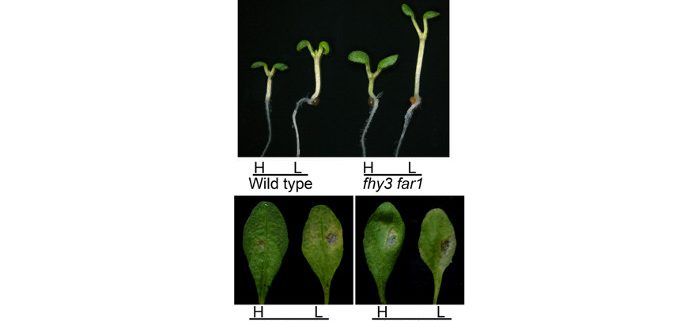Balancing growth and defense in the shade
Liu et al. examine how plants allocate resources between growth and defense in unfavorable conditions.
Plant Cell https://doi.org/10.1105/tpc.18.00991
By Yang Liua and Haiyang Wangb
aBiotechnology Research Institute, Chinese Academy of Agricultural Sciences, Beijing 100081, China
bSchool of Life Sciences, State Key Laboratory for Conservation and Utilization of Subtropical Agro-Bioresources, South China Agricultural University, Guangzhou 510642, China
Background: Plants use a set of red and far-red photoreceptors named phytochromes to detect their light environments and adjust their growth and development accordingly. When sensing a reduction in the ratios of red to far-red light under canopy shade, plants initiate a set of adaptive responses collectively termed shade avoidance syndrome, including elongated growth to compete with the neighbors for limited light resources and accelerated flowering to ensure reproductive success. However, the elongated growth comes at the cost of undermined defensive capability to pathogens.
Question: When grown under unfavorable environmental conditions (such as shade), plants need to make a decision: to grow or to defend? Furthermore, how should they allocate their limited resources between these two opposing processes? We want to understand how plants make such a decision.
Findings: In this study, we showed that FHY3 and FAR1, two homologous proteins involved in transducing the far-red light signal, play an important role in helping plants make such a decision. Specifically, we found that in response to shade, the protein levels of FHY3 and FAR1 increase, and they activate the expression of two downstream transcription factor genes, PAR1 and PAR2. In turn, PAR1 and PAR2 act to regulate downstream genes to repress plant growth. On the other hand, FHY3 and FAR1 proteins physically interact with another set of transcription factors, MYC2/3/4, and together, they activate the expression of downstream defense-related genes to help plants to defend themselves. When the FHY3 and FAR1 genes are mutated, the plants undergo exaggerated growth and exhibit increased susceptibility to the fungal pathogen Botrytis cinerea, which reduces the fitness of plants grown under shade conditions.
Next steps: Increasing planting density is an effective means of increasing crop yield per unit land area, which requires the breeding and utilization of shade-tolerant crop cultivars that can balance their growth and defense. Next, we wish to know whether crop plants use a similar mechanism to balance their growth and defense under shade (or high planting-density) conditions, and to use this knowledge to guide breeding of shade-tolerant crop plants.
Yang Liu, Hongbin Wei, Mengdi Ma, Quanquan Li, Dexin Kong, Juan Sun, Xiaojing Ma, Baobao Wang, Cuixia Chen, Yurong Xie, Haiyang Wang. (2018). Arabidopsis FHY3 and FAR1 Regulate the Balance between Growth and Defense Responses under Shade Conditions. Plant Cell; DOI: https://doi.org/10.1105/tpc.18.00991
Key words: defense-related genes, plant growth, shade-tolerant crop




